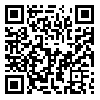Volume 7, Issue 3 (Jul- Sep 2018)
JCHR 2018, 7(3): 147-154 |
Back to browse issues page
Download citation:
BibTeX | RIS | EndNote | Medlars | ProCite | Reference Manager | RefWorks
Send citation to:



BibTeX | RIS | EndNote | Medlars | ProCite | Reference Manager | RefWorks
Send citation to:
Hoseini Hoseinabad S F, Ghobari Banab B, Mashayekh M, Sodagar S, Farrokhi N. An Investigation of Predictive Marital Adjustment Base of Attachment Styles in Married Women. JCHR 2018; 7 (3) :147-154
URL: http://jhr.ssu.ac.ir/article-1-434-en.html
URL: http://jhr.ssu.ac.ir/article-1-434-en.html
Seyede Fateme Hoseini Hoseinabad1 
 , Bagher Ghobari Banab2
, Bagher Ghobari Banab2 

 , Maryam Mashayekh *3
, Maryam Mashayekh *3 

 , Sheyda Sodagar1
, Sheyda Sodagar1 
 , Noorali Farrokhi4
, Noorali Farrokhi4 



 , Bagher Ghobari Banab2
, Bagher Ghobari Banab2 

 , Maryam Mashayekh *3
, Maryam Mashayekh *3 

 , Sheyda Sodagar1
, Sheyda Sodagar1 
 , Noorali Farrokhi4
, Noorali Farrokhi4 


1- Department of Psychology, Faculty of Psychology, Islamic Azad university Karaj Branch, Karaj, Iran
2- Department of Psychology, Faculty of Psychology & Education, Tehran University, Tehran, Iran
3- Department of Psychology, Faculty of Psychology, Islamic Azad university Karaj Branch, Karaj, Iran ,m.mashayekh.@kuia.ac.ir
4- Department of Educational Psychology, Faculty of Psychology & Educational Sciences, Allameh Tabataba'i University, Tehran, Iran
2- Department of Psychology, Faculty of Psychology & Education, Tehran University, Tehran, Iran
3- Department of Psychology, Faculty of Psychology, Islamic Azad university Karaj Branch, Karaj, Iran ,
4- Department of Educational Psychology, Faculty of Psychology & Educational Sciences, Allameh Tabataba'i University, Tehran, Iran
Abstract: (6426 Views)
Introduction: Current figures indicate that many of first marriages in the Iran will end in separation or divorce and due to many problems, one of the causing this phenomenon is marital adjustment. Marital adjustment denotes emotional stability, intellectual efficiency and social effectiveness people and acts as a fundamental contributor to the health and development of family members. One of the most important factors influencing marital adjustment is attachment styles. This study aimed to determine the relationship between attachment styles and marital adjustment in women.
Methods: This cross-sectional study was conducted on 220 women referring to health centers of yazd city in 2016. The participants were selected via available sampling. The data collection instruments consisted of the standardized Questionnaires include Spanier ’s marital adjustment (1976) and Collins and Read’s Adult Attachment Style Scale. The data were analyzed in SPSS software (version 19) using descriptive statistics and Pearson correlation coefficient, and stepwise regression analysis, regression equation.
Results: The attachment styles were predictors of marital adjustment. There was a significant negative correlation between marital adjustment and anxious and avoidant attachment styles while the correlation between marital adjustment and securate attachment style was significantly positive.
Conclusion: The results showed that the early relationship within the family environment supports a certain attachment style and the effects of the avoidant insecure and ambivalent insecure styles affect the interpersonal relations of the couples in adulthood. As attachment styles are contributory to marital adjustment, counselors can build on couple therapy approach to have an effective role in modifying attachment styles of the couple and solving their conflicts both before and after marriage.
Methods: This cross-sectional study was conducted on 220 women referring to health centers of yazd city in 2016. The participants were selected via available sampling. The data collection instruments consisted of the standardized Questionnaires include Spanier ’s marital adjustment (1976) and Collins and Read’s Adult Attachment Style Scale. The data were analyzed in SPSS software (version 19) using descriptive statistics and Pearson correlation coefficient, and stepwise regression analysis, regression equation.
Results: The attachment styles were predictors of marital adjustment. There was a significant negative correlation between marital adjustment and anxious and avoidant attachment styles while the correlation between marital adjustment and securate attachment style was significantly positive.
Conclusion: The results showed that the early relationship within the family environment supports a certain attachment style and the effects of the avoidant insecure and ambivalent insecure styles affect the interpersonal relations of the couples in adulthood. As attachment styles are contributory to marital adjustment, counselors can build on couple therapy approach to have an effective role in modifying attachment styles of the couple and solving their conflicts both before and after marriage.
Review: Research |
Subject:
Public Health
Received: 2018/05/11 | Accepted: 2018/09/26 | Published: 2018/09/26
Received: 2018/05/11 | Accepted: 2018/09/26 | Published: 2018/09/26
Send email to the article author
| Rights and permissions | |
 |
This work is licensed under a Creative Commons Attribution 4.0 International License. |



